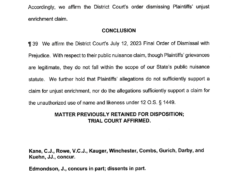The Oklahoma Department of Corrections, which has been paying counties $27 a day per inmate awaiting transfer to state custody, must reimburse county jails for both consumable costs, such as food and clothing, as well as operating expenses incurred as a direct result of holding the inmates, the state Supreme Court ruled today.
While several local and state officials said they were still reviewing the ruling Tuesday, many counties calculate a separate per-detainee number — an “average daily cost” for all jail operations — that is at least double the $27 figure that DOC now pays counties for holding people after a court conviction.
But Tuesday’s ruling appears to require new math on behalf of counties as they calculate hard costs “directly attributable” to housing DOC inmates, a nuance likely to frustrate county sheriffs and commissioners who currently calculate their “average daily cost” by considering overall expenses related to operating a jail. As a result, the ultimate financial implications of the Supreme Court ruling remain unclear.
“It will have a fiscal impact to the state,” Senate Appropriations and Budget Chairman Roger Thompson told NonDoc.
Tulsa County District Attorney Steve Kunzweiler said his office is still reviewing the decision, and he confirmed that state law allows all parties in the lawsuit “to petition for rehearing” before the Supreme Court.
“I would imagine both sides are going to be looking at the import of the decision and make a decision one way or another,” Kunzweiler said. “At this point, we’re weighing our options, just as I imagine the other side is weighing their options.”
Defining the ‘actual daily cost’ to county jails
The 5-4 decision stems from a longtime dispute over how much DOC must pay county jails for detaining inmates after they are convicted but before they are transferred to state custody. Title 57, Section 38 of state statute requires DOC to reimburse a county the cost of housing its inmates, setting the reimbursement rate at $27 unless the actual daily cost exceeds that amount.
For years, the DOC and counties have been unable to come up with an agreeable definition for actual daily cost. The Tulsa County Board of Commissioners asked the State Auditor and Inspector’s Office to calculate Tulsa County’s cost, and the Department of Corrections sued the auditor and the commissioners in Tulsa County District Court.
Amid questions about subject matter jurisdiction, the case went to the Oklahoma Court of Civil Appeals and eventually to the state Supreme Court, which vacated the appellate court ruling Tuesday, determined an “actual daily cost” definition and remanded the case back to Tulsa County District Court for further proceedings.
The justices voted that “actual daily cost” includes consumable costs as well as any cost incurred by a county shown to be “directly attributable” to housing a DOC inmate, according to the majority opinion written by Vice Chief Justice Dustin P. Rowe.
“The term ‘actual daily cost’ encompasses both consumable costs (e.g., food and clothing) as well as those additional costs incurred as a direct result of housing a DOC inmate,” Rowe said. “Costs not directly attributable to the housing (of) a DOC inmate are not reimbursable by DOC.”
In the event the actual daily cost of housing a DOC inmate exceeds $27, and the DOC disputes the county’s proposed rate, the state auditor will calculate the actual daily cost, the opinion states.
“We hold ‘actual daily cost’ includes both consumable costs as well as those additional costs that are directly attributable to housing a DOC inmate,” Rowe wrote in the opinion joined by Chief Justice M. John Kane IV and Justices James Winchester, Noma Gurich and Dana Kuehn.
The majority opinion states it is undisputed that the actual daily cost of housing a DOC inmate includes “consumable costs” like food, clothes and medical care. But the question of whether “fixed costs,” which constitute the jail’s operating expenses, are included within the actual daily cost has lingered.
“Operating expenses are not necessarily dependent on the number of prisoners, as some operating expenses are inevitably incurred regardless of whether a DOC inmate is housed in a county jail,” Rowe said. “However, there may be instances when a jail’s operating expenses increase due to housing a DOC inmate. For example, if a county jail employs a set number of jailers in the regular operation of its jail, that cost is not directly attributable to housing a DOC inmate. If, however, a county jail employs an additional jailer and demonstrates the hiring of the additional jailer is directly attributable to housing a DOC inmate, such cost would exist in fact and be included in the actual daily cost.”
In a dissenting opinion joined by Justices Yvonne Kauger, James Edmondson and Richard Darby, Justice Douglas Combs took issue with Rowe’s interpretation of “actual daily cost” being limited to only “directly attributable” costs.
“[Title 57, Section 38] provides ‘the reimbursement [is] to defray expenses of equipping and maintaining the jail and payment of personnel,'” Combs wrote. “It does not say, as the majority opinion asserts, that it is for payment of personnel that have been hired to take care of a specific inmate. In order to ‘house’ an inmate you must have a house, a functioning facility, staffed and equipped to house an inmate on any given day or days.”
Thompson (R-Okemah) said he anticipates prisoners in county jail custody after conviction will be transferred to DOC more quickly, one way or another.
“I think some of these state prisoners being housed in the county jails will be pulled into the state system,” he said.
He said some counties may have been tardy in informing DOC when an inmate had been sentenced so they could draw DOC reimbursement for an additional day or two.
“Quite frankly, there have been some county jails that have used this as income,” Thompson said.
State auditor: Ruling is ‘extremely unfortunate’

State Auditor Cindy Byrd was disappointed in the Supreme Court’s ruling, noting that Rowe’s opinion stops short of saying DOC must pay counties for the per-prisoner average daily cost calculated by each county for overall jail operations.
Byrd said the Oklahoma Constitution prohibits local taxpayer funds from being used to pay for expenses the state should be incurring, such as the housing of inmates transferred to state custody after conviction in district court.
“Today’s ruling by the state Supreme Court is extremely unfortunate,” Byrd said in a statement. “It places a financial hardship on all 77 counties. The state Constitution is clear that no local taxes may be spent on services for which the state is responsible. State inmates are the sole financial responsibility of the state Department of Corrections, not our counties. Our county property taxes are what fund our county jails.”
Byrd added that she believes the DOC is using the situation to its benefit at the expense of county governments across the state.
“Sadly, the DOC is taking advantage of counties by housing inmates at their jails at a rate of $27 per day when the actual cost, according to the DOC’s own numbers, ranges from $57 to $108 per day,” Byrd wrote. “Because the counties are now forced to incur these costs, the citizens will receive fewer core services from their counties, such as road repairs and law enforcement. Regardless, of course, my office will comply with the court’s opinion, and I look forward to justifying these costs back in district court.”
‘Just doesn’t cover the cost’

Kay Thompson serves as chief of public relations for the Oklahoma Department of Corrections. Asked how much DOC pays to counties jails annually for housing inmates post-conviction, Kay Thompson said the state paid out $9.7 million in Fiscal Year 2022 and $10.2 million in Fiscal Year 2023, which ended June 30.
“We are still evaluating the opinion and look forward to working with the county jails and the Oklahoma Sheriffs’ Association about the appropriate next steps,” said Kay Thompson, who is the daughter of Sen. Roger Thompson.
Joe Allbaugh serves as the chairman of the Oklahoma County Criminal Justice Authority, which manages the troubled Oklahoma County Jail. A former DOC director himself, Allbaugh said the reimbursement rate for DOC inmates in county jails has to go up.
“Those who are incarcerated have received their judgment and sentencing and are waiting to be taken into the DOC system,” he said. “There are 28,000 people system-wide or so, so the cost of inflation and feeding and the medical care of those individuals is high. But we can’t have a cap at some arbitrary number, because it just doesn’t cover the cost. Someone has to pay for it. The cost ends up being taken over by the county.”
Allbaugh, who had not read the opinion Tuesday afternoon, said this is a statewide problem and it’s an issue that the DOC and Legislature should address.
“There has been an unwillingness to pay attention to our correctional system statewide, and it affects everyone involved from male and female detainees to staff to our county jails because the law requires a certain level of care,” he said. “But no one ever steps forward to be a leader in this area which has been extremely frustrating for myself and other trust members who serve on a volunteer basis. For the most part, county commissioners and staff are aware of those concerns but there’s only so much money to deal with it. But it needs to be dealt with sooner or later. Sooner rather than later.”
Allbaugh said more than 100 DOC inmates, both men and women, are at Oklahoma County’s detention center currently. Those individuals transfer from county to state custody after the county submits judgment and sentence documentation to DOC.
“It’s an issue that needs to be resolved across the board,” he said. “We have done a recent calculation, and we are in the process of doing an independent third-party calculation, and they are doing the exact dollar amount required.”
The Oklahoma County Jail’s average daily cost is set by District Judge Natalie Mai, according to spokesman Mark Opgrande.
“This year she set it at $61.73 a day,” Opgrande said. “That is the daily amount we can charge detainees for being incarcerated. (Currently) DOC only pays us $27 a day per the statute for each day they are here until they are moved to DOC.”
Casey Roebuck, public information officer for the Tulsa County Sheriff’s Office, said the Tulsa County Jail’s average daily cost is $63.42, a figure that was arrived at with assistance from the state auditor’s office.
Average daily costs for county jails fluctuate from year to year. In August, the Seminole County Board of Commissioners adjusted its average daily cost from $67.54 down to $57.51 owing to calculations presented by District Attorney Erik Johnson.
Background outlining Supreme Court’s decision
In 2011, then-state Sen. Josh Brecheen (R-Colgate) formally asked the state attorney general to examine the DOC rate dispute, but the Attorney General’s Office did not state whether the $27-per-day rate specified by state law was sufficient to cover counties’ costs.
The Bryan County Board of Commissioners challenged the law in court, and the district court ruled that when costs exceed $27 the county is entitled to reimbursement from the state of Oklahoma “to fully reimburse the costs of housing incurred by the county for such inmate without being limited by the cap limit” of Title 57, Chapter 1, Section 38.
DOC appealed, and the Court of Civil Appeals affirmed the decision.
Tulsa County then hired a national firm specializing in calculating jail costs and rates to study rates at the Tulsa County Jail, known as the David L. Moss Criminal Justice Center. At the time, the firm determined Tulsa County’s actual daily cost for housing, caring for and feeding inmates was $55.81 per inmate per day. Tulsa County sought reimbursement for that amount, but DOC rejected the request. Tulsa County’s commissioners and the Tulsa County Criminal Justice Authority sued DOC.
About the same time, legislators amended state law by passing a bill that took effect Nov. 1, 2017, and remains in effect today. The law provides a procedure when a county and the DOC disagree on the actual daily cost of housing a DOC inmate. It instructs a county to notify DOC if the actual daily cost of housing a DOC inmate is more than $27 a day no later than Sept. 30. If DOC agrees, the agency will pay that rate beginning the next fiscal year.
If DOC rejects that rate, then the state auditor and inspector will determine the reimbursement rate, which shall by imposed beginning the next fiscal year, the law states.
Despite the amended law, Tulsa County did not seek a reimbursement rate from the state auditor’s office and continued its lawsuit in district court. DOC argued it should not have to reimburse Tulsa County for the fixed costs of operating the jail.
A judge ruled that Tulsa County’s reimbursable costs cannot include fixed costs, instead limiting reimbursement to the actual costs of feeding, housing, clothing and providing medical treatment.
Tulsa County then asked the state auditor’s office to determine the actual daily costs of housing a DOC inmate. The state auditor’s office agreed, and Tulsa County dismissed its case against DOC. The state auditor’s office notified Tulsa County that the actual daily cost to house a DOC inmate was $63.42.
In 2020, DOC filed a petition for review in Oklahoma County District Court against Tulsa County and the state auditor’s office to set aside the state auditor’s reimbursement rate. A district court judge agreed with Tulsa County and the state auditor’s office that it lacked subject matter jurisdiction, but they also concluded that the state auditor’s method to determine actual daily cost was rational. DOC objected, and the case was sent to the Court of Civil Appeals, which reversed and remanded the district court’s ruling and determined that the Legislature intended the phrase ‘actual daily costs’ to include fixed costs.
Both DOC and the state auditor’s office sought certiorari review with the Supreme Court. DOC contended the Court of Civil Appeals’ determination that actual daily costs include fixed costs was incorrect, and the state auditor’s office contended the Court of Civil Appeals erred finding the district court had jurisdiction over the dispute because the state auditor was exercising her discretionary executive power granted to her by the Legislature and that interference by the courts would violate the separation of powers.
Read the Oklahoma Supreme Court majority opinion
 Loading...
Loading...
(Update: This article was updated at 1:40 p.m. Wednesday, Oct. 11, to clarify the number of DOC inmates in the Oklahoma County Jail. It was also updated to provide additional information about the process of post-conviction transfers.)





















